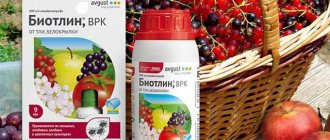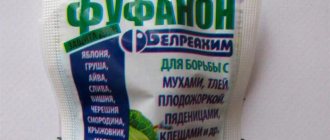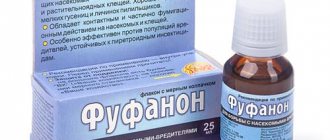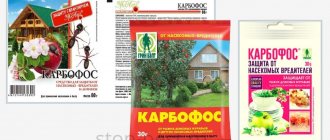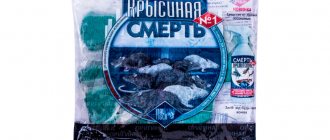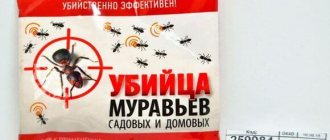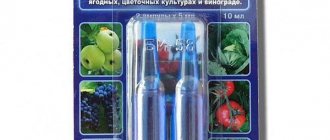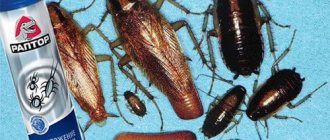Purpose and general characteristics
The drug "Fufanon" is intended to protect many crops from numerous pests and to destroy synanthropic insects.
Let me remind you that synanthropes are those insects that are associated with human habitation and are practically never found in the wild. The drug "Fufanon Super" is intended for the destruction of cockroaches, house flies, red house ants, bed bugs, moths, cat and dog fleas, mosquitoes, mosquitoes, flies, etc.
The action of the drugs “Fufanon KE”, “Fufanon Nova” is aimed at protecting plants from a number of pests - whitefly , herbivorous mites, aphids , thrips, sawflies, scale insects, false scale insects, mealybugs, codling moths, weevils , leaf rollers, gall midges, moths, etc.
Answers to 5 pressing questions
If disinfestation is carried out according to all the rules, then the bedbugs will be completely destroyed - starting from mature individuals and nymphs, ending with larvae and eggs. Insects will begin to die within the first hours after treatment, but the entire domestic population will die out no earlier than three days later. Below are answers to five of the most frequently asked questions.
- What to do if the room is infested with bedbugs? If a house, apartment or office is heavily infested with bloodsuckers, experts recommend re-treatment with Fufanon. When using the Nova variety, the concentration of the drug must be increased. Since the product retains its barrier effect for 14 days, repeated disinsection should be carried out no earlier than two weeks later.
- What if after disinfestation several larvae remain untouched? The procedure must be carried out as carefully as possible. Even a few surviving eggs or larvae will lead to a rapid restoration of the population to its former size.
- Is it possible to open windows during spraying and after treatment? Not only is it possible, but it is also necessary. The pungent odor of the drug can cause poisoning, so the windows in the apartment should be wide open until the household returns from exile.
- Is it necessary to clean up after spraying poison? After baiting insects, a day later, the entire house needs to be washed with a soda solution. To do this, dissolve 400 g of soda in a bucket of water, thoroughly wash furniture, floors and objects that a person comes into contact with in everyday life. There is no need to treat hard-to-reach places - let their smell continue to scare away uninvited guests.
- When can I return home? Not earlier than 24 hours after treatment with soda solution.
If Fufanon gets on the skin, the affected area should be immediately washed with soap and water. If the poison gets into your eyes, you need to rinse them well under running water, and after dropping a 2% solution of novocaine, be sure to see an ophthalmologist or family doctor. If you feel an unpleasant bitter taste in your mouth, rinse your mouth with a weak solution of soda and go out into the fresh air. If the condition does not improve within an hour, call an ambulance immediately.
Users confirm the effectiveness of the drug, but at the same time focus on its unpleasant odor. If this aspect is extremely important to you, give preference to the microencapsulated form of the chemical. This concentrate has almost no smell, but it acts exactly the same as its liquid counterparts - it kills bloodsuckers quickly and on the spot.
Types of drug, dosage form and composition
“Fufanon” is an insectoacaricide, according to its chemical class it belongs to the FOS group of pesticides (organophosphorus compounds). According to the method of penetration, it is classified as a contact-intestinal pesticide.
The composition of the drug is the active substance (AI) malathion (440-570 g/l), surfactant (surfactant), solvent, stabilizer, thickener, buffer solution and inert filler up to 100%.
Currently, the drug is available in 4 versions, different in scope:
1. “Fufanon, CE” (emulsion concentrate), dosage DV 570g/l. Used in private household plots, agricultural production and on grains, legumes and other industrial crops. Process grain and vegetable storage facilities. It has a “smelly” distinct odor. Release form: 5 ml ampoules, 25 ml bottles, 5.0 l canister.
2. “Fufanon-Nova, VE” (water emulsion), DV dosage 440 g/l. A product for controlling agricultural pests in private household plots and small farms. Release form: 2 ml ampoules. and 6 ml., 0.5 l bottles.
3. “Fufanon-Super, VE” , malathion dosage 440 g/l. The drug is used primarily to combat synatropic insects. Release form: 5 ml ampoules and 0.2-1.0 l bottles.
4. “Fufanon Expert, VE” (new) - DV dosage 440 g/l. An effective insectoacaricide for the control of gnawing and sucking pests of agricultural crops in industrial agriculture.
Mechanism of action
The drug belongs to organophosphorus compounds. Thanks to the active substance, when treating premises, pests lose their ability to move after 1.5-2 hours. After spraying, the insects die within 24 hours.
However, it must be taken into account that regular use of the drug contributes to the emergence of populations of insects and pests that are resistant to the action of malathion. Insects develop the physiological ability to destroy the active substance into products that are non-toxic to the body.
Processing regulations
Let's consider the regulations for the use of Fufanon preparations (consumption rates, dosages, waiting periods, frequency of treatments) against pests based on the characteristics of use:
- in private household plots - personal subsidiary plots;
- in industrial agricultural production;
- to combat synanthropic insect pests.
Application in private household plots (personal subsidiary plots)
Examples of Fufanon CE preparations from various manufacturers
Treatment is carried out by spraying and/or irrigation. The working solution is prepared and used on the day of treatment. Spraying is carried out in the evening or morning in calm weather. The minimum waiting period is at least 3-6 hours.
| Application rate/dosage | Processed crop | Pest | Features of application | Waiting period | Frequency of treatments |
| 12-14ml./10l. water | Pome crops - apple, pear, quince, etc. | Aphids, codling moth , mite, apple flower beetle, weevil, leaf roller, copperhead, sawfly, scale insect, false scale insect | Spraying treatment during the growing season. Working fluid consumption – 2-5 l./tree (depending on age and variety) | 20 | 2-3 |
| 12ml/10l. | Currants and gooseberries | Moth, aphids , moths, gall midges, leaf rollers, sawflies, scale insects, false scale insects | Spraying, consumption 1-1.5 l/bush | 20 | 2 |
| 10-12ml/10l. water | Stone fruits - plum, cherry, sweet cherry, apricot | Codling moth , leaf beetle, aphid, moth, weevil, sawfly, cherry fly, silkworm, moth, scale insect | Spraying treatment during the growing season. Working fluid consumption – 2-5 l./tree (depending on age and variety) | 20 | 2 |
| 11.5-12/10l. water | Strawberries | Mite, sawfly, raspberry weevil | Double treatment (before and after flowering) by spraying. Working fluid consumption - 1.5 l./10 m2. | 20 | 2 |
| 13ml./10l. water | Vegetables - cabbage, tomato, cucumber | Mites, aphids, thrips, sprout flies, cabbage cutworms, whiteflies , whiteflies, moths, thrips, etc. | Spraying during the growing season, consumption -1l./10m2 | 20 | 2 |
| 13ml./10l. water | Grape | Mealybug, mite | Spraying treatment during the growing season. Working fluid consumption – 2-5 l./bush (depending on the age and size of the bush) | 20 | 1-2 |
| 13ml./10l. water | Decorative shrubs and flowers | Pest complex | Double spraying (before and after flowering), consumption -1.5-2l./10m2 | No | 2 |
If some crops and/or pests were not listed in this table, then the application rates, waiting times and frequency of treatments can be viewed in the following table by recalculating the corresponding indicators.
Examples of the drug "Fufanon Nova"
Application of "Fufanon" in industrial agricultural production
| Application rate/dosage | Processed crop | Pest | Features of application | Waiting period |
| 0,7-1,6 | Cereals - wheat, barley | Aphids, thrips, wheat thrips | Spraying treatment during the growing season. Working fluid consumption – 2-4 l/100m2 | 30 |
| 0,8-1,5 | Corn | Leafhoppers, leaf aphids | Spraying, consumption 2-4l/100m2 | 20 |
| 0,7-1,6 | Legumes - peas | Aphids, bean moth, pea weevils and codling moth | Spraying, consumption 2-4l/100m2 | 20 |
| 1,3-1,6 | Sugar beet | Leafhoppers, bugs, leafminers, flies and moths, beet aphids | Spraying, consumption 2-4l/100m2 | 20 |
| 1-1,3 | Pome crops - apple, pear, quince, etc. | Codling moths, leaf rollers, mites, aphids, sawflies, scale insects, false scale insects, weevils, copperheads, etc. | Spraying treatment during the growing season. Working fluid consumption – 6-15l/100m2 | 20 |
| 1,3 | Stone fruits - cherries, sweet cherries, plums, apricots | Sawfly, aphids, weevil, codling moth, cherry fly | Spraying during the growing season, consumption 8-12l/100m2 | 20 |
| 1-1,5 | Sea buckthorn | Aphids, gall mite, copperhead, etc. | Spraying, consumption 5-8l/100m2 | — |
| 1,3-2 | Currants, gooseberries | Sawflies, scale insects, false scale insects, aphids, moths, gall midges, leaf rollers, moth | Spraying, consumption 8-12l/100m2 | 20 |
| 1,3-3,4 | Raspberries | Mites, aphids, raspberry-strawberry weevil, raspberry bud moth | Spraying before flowering and after harvesting, consumption 8-15l/100m2 | — |
| 1-1,2 | Strawberries, garden strawberries | Sawfly, whitefly, weevil, strawberry mite | Spraying, consumption 3-5l/100m2 | 20 |
| 1,3 | Grape | Mealybug, mites | Spraying during the growing season, consumption 8-12l/100m2 | 20 |
| 1 | Decorative garden shrubs | Aphids, mites, moths, leaf rollers, copperheads, etc. | Spraying, consumption 10-15l/100m2 | — |
| 0,8-1,6 | Cabbage | Whitefly, cabbage cutworms, whitefly, moths, aphids, thrips | Spraying, consumption 3-4l/100m2 | 20 |
| 0,8-1 | Rapeseed, sunflower | Cruciferous blight, rapeseed sawfly, bugs, leaf beetles, aphids | Spraying, consumption 2-3l/100m2 | 30-40 |
| 1,5 | Soybeans | Leaf beetles, mites, aphids, cutworms | Spraying, consumption 2-4l/100m2 | 30 |
| 0,8-1,6 | Open ground cucumber | Whitefly, mites, sprout flies, aphids, thrips, | Spraying during the growing season, consumption 2-4l/100m2 | 20 |
| 1,5-4,5 | Cucumber in greenhouses | Whitefly, mites, thrips | Spraying during the growing season, consumption 10-30l/100m2 | 1-3 |
| 0,8-1,6 | Open ground tomato | Whitefly, aphids, mites | Spraying during the growing season, consumption 2-4l/100m2 | 20 |
| 1,5-4,5 | Tomato in greenhouses | Whitefly, nightshade fly, thrips, mites | Spraying during the growing season, consumption 10-30l/100m2 | 1-3 |
Control of synanthropic insect pests (for the drug “Fufanon Super”)
The drug "Fufanon Super" to combat synanthropic insects
| Pest | Application rate/dosage | Consumption rate | Features of application | Frequency of treatments |
| Cockroaches | 10-20ml/1l of water | 100ml./1m2 | Treat thresholds, cracks, baseboards, along pipes and other habitats of cockroaches, as well as behind furniture, under the sink and bathtub. | 1-2 |
| flies | 10ml./1l.water | 500ml/1m2 | They treat garbage bins, livestock premises, and spray the product on the walls. Cesspools and yard toilets are also treated. | 1 |
| Fleas | 3.5-5ml/1l.water | 100ml./1m2 | The treatment is carried out by spraying the working solution onto the walls, floor, and along the baseboards. | 1-2 |
| Bed bugs | 3.5ml/1l.water | 100-200ml./1m2 | Apply the drug in habitats and concentrations of insects. Bedding cannot be processed. | 1-2 |
| Mosquitoes | 5-10ml/1l.water | 50-100ml./1m2 | Treatment is carried out by irrigation; when used indoors, after treatment, ventilate well after 2-3 hours. To destroy the larvae, the concentration is increased 3 times. | 1 |
| Red house ants | 5-10ml/1l.water | 100ml./1m2 | Treat areas where ants gather and move around | 1-2 |
Step-by-step instructions for use
In order for the product to give the expected result, you must strictly follow the instructions on the packaging. It is prohibited to start working with the insecticide without studying this information. Neglecting protective measures can cause deterioration in health.
The main symptoms of poisoning are a sudden loss of strength, nausea, vomiting and severe dizziness. In such a situation, you need to go out into the fresh air, take a sorbent, and wait for the doctor to arrive. To avoid negative consequences, carefully prepare for the liquidation operation.
Preparatory activities
The first thing you have to do in the list of preparatory activities is the so-called “reconnaissance in force.” It’s good if you know exactly where bedbugs accumulate. To do this, move all cabinet and upholstered furniture away from the walls, check the most inaccessible places for the presence of chitinous shells and waste products of these disgusting insects. It is impossible not to notice the nest: it gives the impression of a lichen, unkempt place that you don’t want to touch, which is unpleasant to be near.
Safety precautions
At the second stage, the step before disinfestation, you should take care of your safety. The following attributes will help you with this:
Pets and household members must leave the family nest before disinfestation begins. Indoor flowers also need to be taken out. If there is a terrarium or aquarium in the house, the surface of the vessel must be covered with thick cardboard or a wooden barrier so that the chemical does not penetrate into the water.
Solution preparation and processing
To dilute the drug, take any container that has a non-food purpose and follow the instructions presented in table form.
Table - How to breed "Fufanon"
| Pests | Quantity of insecticide, ml | Quantity of water, ml | Consumption of the finished solution, ml/m2 |
| — Bugs; - ants; - fleas | From 1.5 to 3.5 | 1000 | 50 |
| — Flies; - cockroaches | — 9; — 11 | 1000 | 100 |
The chemical, packaged in ampoules, is diluted differently. To do this, one 5 ml ampoule is poured into a large container, and 5 liters of water are added there. Some sources indicate that the finished solution can be applied using a wide paint brush. However, spraying the drug using a sprayer or spray bottle is considered the most comfortable. When disinsection, the following recommendations should be followed.
Restrictions and security
The drug has passed state registration in the Russian Federation (No. 058-01-190-1, approved until 2023).
The drug is classified as hazard class 3 to humans. When working with the drug, it is necessary to use personal protective equipment. It is necessary to comply with the output standards - they are 10 days for manual work and 3-4 days for mechanized work.
The use of the drug in the water protection zone of reservoirs is prohibited. There are also restrictions when using the drug during the flowering period - the drug "Fufanon Nova" belongs to the 1st class of danger for bees.
Security zones:
- from water supply sources - at least 50 m, and the opening of reservoirs - 1.5 km;
- residential premises - at least 15 m;
- apiaries - up to 5 km. for “Fufanon Nova” and at least 2 km. for "Fufanon KE".
Repeated treatments are carried out according to entomological indications.
Active substance
Fufanon-Nova is an aqueous emulsion of malathion, an oily chemical from the group of organic phosphorus compounds. Malathion was first synthesized in the mid-20th century.
Main toxic properties:
- Highly toxic to insects, even in low concentrations.
- Low toxicity for mammals and humans in similar dosages (hazard class 3). An average degree of harm to human health occurs only with close contact with large volumes of concentrated substances.
- Mortal danger to bees (class 1).
- Moderate harmful effect on ticks and scale insects.
- No effect on plant development (no phytotoxicity).
- Rapid decomposition under the influence of wind and/or water: in greenhouses in 5 - 7 days, in the open air in 10 days.
- Relative resistance to ultraviolet radiation, as well as temperatures in the range from zero to +50 degrees.
- Neutralization in an alkaline environment.
Malathion:
- quickly eliminated from the body of mammals (including humans);
- does not accumulate in animal and plant tissues;
- is not a carcinogen;
- destroyed during heat treatment of food.
More on the topic: Herbicides against weeds on strawberries
Advantages and disadvantages of the drug
The advantages of the drug include the following:
- The drug is suitable for protecting most plants ;
- Highly effective against a whole range of insect pests (sucking, gnawing insects and herbivorous mites);
- Has a fumigant effect with low toxicity;
- “Fufanon” works both independently and as part of tank mixtures, and is well compatible with other insecticides;
- Quick initial action , waiting period - from several hours to 1 day;
- Long-term protective effect – 2-4 weeks;
- Modern DV formula from a European manufacturer (Denmark);
- Low cost of the drug.
The disadvantages include those that are characteristic in general for pesticides of the FOS group, including:
- It has resistance , so it must alternate when used with drugs of another group;
- It is a mutagen , which requires strict adherence to the instructions for use (dosages and work schedule);
- Highly toxic to fish and bees;
- "Fufanon", being a fumigant, has a strong unpleasant odor , which limits its use when processing berry crops
How to store
To store the insecticide indoors, select a dry, ventilated place inaccessible to children and pets. It is prohibited to store animal feed, drinking water, or food in the room.
The shelf life of the pesticide is 2 years from the date of manufacture. It is not recommended to store unused working solution (it must be disposed of according to the rules).
What do users say about the toxicity of fufanon?
№8. Fufanon still has the same smell, of course. Personally, I developed an allergy from it; acne from bedbug bites was replaced by allergic ones. So I had to give up this product, although it fights bedbugs really well.
№9. If you want to deal with bedbugs with a guarantee, you need to come to terms with the disadvantages of fufanon - the smell and the need to be careful. Proceed carefully, according to the instructions, ventilate the room well after treatment, and there will be no problems.
№10. I don’t understand why use such a smelly drug if there are modern products that are not inferior in effectiveness to karbofos, and at the same time odorless. If you inhale the poison, you will get a headache for several days or even weeks. Fufanon is a vegetable garden product.
№11. You can’t say anything, the drug is really effective, but it has a very unpleasant and corrosive smell. We've been getting rid of it for several weeks, it doesn't seem to smell anymore, but still the smell is barely noticeable in the air.
№12. In fact, it all depends on the characteristics of our sense of smell. If you are not allergic to smells and your sense of smell is not too sensitive, you can use Fufanon. Well, if you react sharply to all sorts of odors, not to mention allergies, then you need to buy something without a strong smell.
As you can see, there are so many people, so many opinions. If we try to sum up all the consumer reviews about Fufanon, then it could be like this.
- If you are allergic to odors or have a very sensitive sense of smell, give preference to another drug.
- When processing, be sure to use PPE - respirator, gloves, goggles, tightly fastened clothing.
- Ventilate the room thoroughly after treatment.
Procedure for removing parasites
In the vast majority of cases, SES workers remove bedbugs in one sanitary treatment. But even before this procedure is carried out, a specialist goes to the site - a city apartment, a residential building, a cottage community - to clarify the situation on the spot.
Often, during such an inspection, the residents of the premises learn a lot of new things not only about the number of bedbugs in their apartment, but also about the situation with them among their neighbors. In addition, the visiting inspector of the Sanitary and Epidemiological Station always has extensive experience in exterminating not only bedbugs, but also other insects, and knows very well where to look for them, in which places the main populations are kept, and how to find bedbugs in places where it is difficult to even look.
In many cases, after inspecting the premises, the SES specialist orders that neighboring apartments be examined and treated. This is especially true for apartment buildings: here, the first to raise the alarm may be the residents of apartments that are not the most infested, while, perhaps, their neighbors live next door to a real bedbug infestation.
See also our experiments on bedbugs:
We catch bedbugs and test different products against them - see the results...
- We test the effect of Hector powder on bedbugs in two options: simple treatment and preparation of traps. See the results of the experiment. An experiment on bedbugs: at what temperature do they die and how can this be used in practice? We put the bedbugs in a container that was treated with the Executioner product a week ago - we’ll see if the parasites are poisoned by the long-dried product...
- We tested the Get Express product on bedbugs - let's see what came of it... Experiment on bedbugs: The Executioner killed them in 8 minutes
We check the residual effect of the Executioner on bedbugs (how quickly they are poisoned upon contact with a previously treated, but already dried surface) - Proven methods of killing bedbugs that have shown to be highly effective
In some cases, the Sanitary and Epidemiological Station inspector makes such visits to inspect the premises several times - to assess the increase in the number of parasites and their possible spread.
Before sanitizing the premises, an agreement is signed between the customer and the SES to carry out pest control work. Based on the concluded agreement, the SES already prescribes treatment for bedbugs.
Wherein:
- At the Sanitary and Epidemiological Station, tactics are being developed for the destruction of bedbugs and other insects, depending on their species composition and number. To the credit of the SES, it should be noted that many other pest control companies almost never carry out such work.
- A means to kill bedbugs is selected.
- Actual measures to exterminate insects are being carried out.
- Subsequently, a representative of the SES monitors the effectiveness of the sanitation performed.
It is usually considered that sanitation against bedbugs is effective if bedbugs have not appeared in the room within two months after it has been carried out.
Sanitation for bedbugs is carried out in a room from which all residents and pets have been removed. In this case, all accessible surfaces, contaminated furniture and clothing are treated. After the work is completed, the responsible specialist draws up an acceptance certificate for the work performed, which indicates the area of the treated premises, as well as the quantity and type of insecticidal agent used.
To treat an infected area, you need to use a stronger concentration. In this case, dilute one ampoule in 5 liters of water. To treat hard-to-reach places where parasites most often live, you can prepare a powerful solution. To do this, mix 5 ml of Fufanon per 1 liter of water. This is a dangerous composition that should only be used by a specialist.
- If the product touches the skin of the face or eyes, immediately rinse the area with clean water. It is best to consult a doctor after this to avoid side effects.
- You need to leave the apartment for a day after treatment.
- When processing, you need to ventilate the room so as not to be poisoned by the chemical composition.
- After the procedure, you need to thoroughly wash your body.
Remember that all insects will die only after 3-4 days. The product will act on both adult bedbugs and bedbug larvae. If the room is heavily infested with insects, treat it several times to eradicate all the bugs in the apartment.
We fight bedbugs correctly
It is necessary to begin treating premises with Fufanon against bedbugs and other pests by first studying the instructions, which contain special information on the preparation of a working water emulsion.
The package should be opened, the required amount of the drug should be poured into a non-food container and diluted with water at room temperature to obtain 1 liter of solution:
- to get rid of bedbugs, fleas and ants, the product should be diluted at the rate of 1.5-3.5 ml per 1 liter of water, depending on the degree of infestation;
- against various types of flies and cockroaches, the product is diluted at the rate of 9 and 11 ml per 1 liter of water, respectively.
- when using the liquid form of the drug in ampoules, the method changes slightly: the contents of one ampoule (5 ml) are diluted in 5 liters of water.
The consumption rate of the working (that is, already diluted) emulsion is 100 ml per 1 square meter of room when treating against flies and cockroaches and 50 ml per 1 square meter when treating against bed bugs, fleas and ants.
For convenience, it is recommended to apply the product using a sprayer or a soft paint brush as follows:
The premises are carefully processed around the perimeter - along the surface of the walls, along the baseboards and borders (the furniture is moved aside), as well as in all hard-to-reach places
Bedbugs hide well, so it is important to pay special attention to cracks in walls and floor coverings, places where wallpaper is coming off the walls, ventilation grilles and objects with their backs facing the walls (carpets, frames, paintings, etc.). Furniture is processed from the bottom side, closer to the floor. If there is a need to treat clothing, upholstery and pillows, they should subsequently be washed well at high temperatures or taken to dry cleaning
When treating an apartment or house in winter, household items can be taken out onto the balcony or into the yard - bedbugs do not survive at temperatures below minus 22°C
If there is a need to treat clothing, upholstery and pillows, they should subsequently be washed well at high temperatures or taken to dry cleaning. When treating an apartment or house in winter, household items can be taken out onto the balcony or into the yard - bedbugs do not survive at temperatures below minus 22°C.
When Fufanon is used correctly, bedbugs leave after the first thorough treatment, but the death of the entire population occurs no earlier than 3-4 days. If the premises are heavily infested, they are treated repeatedly at intervals of two weeks - this is the average incubation period for bedbug eggs
When Fufanon is used correctly, bedbugs go away after the first thorough treatment, but the death of the entire population occurs no earlier than after 3-4 days. In case of severe infestation, the premises are treated repeatedly at intervals of two weeks - this is the average incubation period for bedbug eggs.
In addition, control methods should be alternated and treated in the most thorough manner: if at least a few insect larvae or eggs remain, the entire population of bed bugs will be restored as soon as possible, and new individuals will develop resistance to Fufanon.
